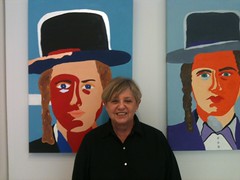 Kathryn Doyle Toby Salkin painted these religious Jews, which
Kathryn Doyle Toby Salkin painted these religious Jews, whichshe calls “Boychicks,” based on a photo she took
in JFK two years ago
Every year in April, Allen Salkin, a onetime East Village resident and former staff writer for The New York Times, throws a spring frolic for an eclectic group of friends and colleagues. This year, it will double as his 70-year-old mother’s downtown art-world debut.
Mr. Salkin, who now lives on Forsyth Street, asked a friend who owns a gallery in his building if he could use it to give his mother a one-woman show. Yesterday, Toby Salkin filled the walls of the modest space with as many of her oil paintings as would fit. Among the bright blues and rusty oranges was the face of a conspicuously mustachioed cowboy: Randy Jones of the Village People.
Her son – who taught the urban cowboy’s boyfriend, Will Grega, at N.Y.U.’s Arthur L. Carter Journalism Institute – had put her in touch with the portrait’s subject. “He walked into the apartment; he was as tall as the ceiling, and he had a cowboy hat and pancake makeup on,” Ms. Salkin said, recalling her first meeting with Mr. Jones. “His boyfriend was carrying pictures of Randy, in case anyone wanted one. So I made this painting and then I thought, you know what, I’m going to do the Village People.” Two portraits of the band’s Native American chief flank Randy.
“One of these days I’ll do the policeman and the construction worker,” she said. “They’re really fun to do.”
Ms. Salkin was born in New York on April 2, 1942 and lived here for the first 25 years of her life, visiting the Lower East Side a few times a year. She has loving memories of the neighborhood. “There were horse-drawn carriages,” she said. “It sounds like the eighteen hundreds but it wasn’t – I’m only 70. They had fruits and vegetables, and everything was discounted, you came down here to buy your underclothes before school started, you bought everything by the dozen. There were candy carts on every corner.”
She moved to Manhattan when her mother died, when she was 20. Shortly after, an older sister, Gwen, died from complications of an eating disorder, and a younger sister, Bonnie, died of a drug overdose. After moving to California, she spent many years working in real estate, retiring seven years ago when her second husband, Joel, passed away. She returns to New York every April.
This year, her son decided to make her homecoming a special one. “Basically, I know my mother has had to put aside many things during her life – enduring many, many losses, including her father who died in a car accident when she was sixth months old, the deaths of two sisters – and yet has persevered with aplomb,” he said. “Now, at 70, full of life still, she is finally fully basking in the thing she loves and starting to see some flickers of success, devoting herself full-time to painting, collage and other art forms, even poetry, all of this working out of her small condominium in suburban Los Angeles.”
In addition to paintings, the show will feature a collage titled “Freedom, Lower East Side, New York” – an ode to the neighborhood’s history as a refuge during the Nazi years. It includes a photograph of Rose and Sam, the artist’s grandparents, who came from Poland to escape the pogroms.
The adjacent painting is called “Tenement Building on Orchard Street.”
“I might do a series of more buildings on the Lower East Side,” said the artist. “How gorgeous, the brick and window treatments.”
The opening reception for “Faces and Houses” is Saturday from 6:30 p.m. to 9:30 p.m. at 208 Gallery, at 208 Forsyth Street.
This post has been revised to reflect the following correction:
Correction: April 26, 2012
An earlier version of this post misidentified the program under which Mr. Salkin taught Will Grega.



